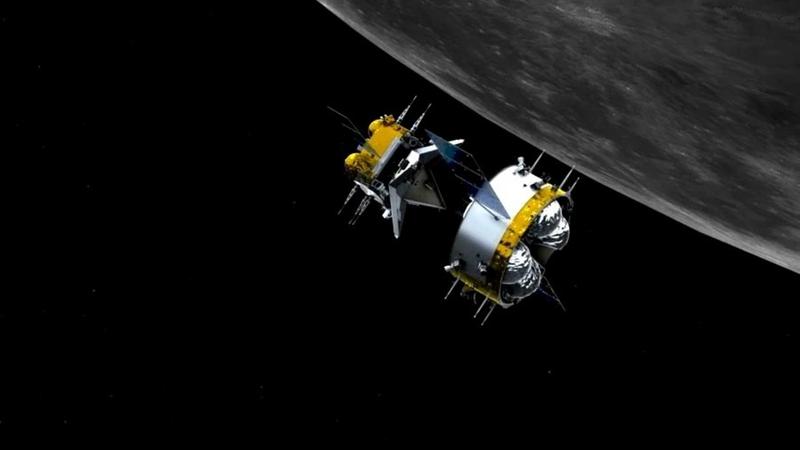 This undated file photo shows a graphic simulation shows the orbiter and returner combination of China's Chang'e-5 probe after its separation from the ascender. (PHOTO / XINHUA)
This undated file photo shows a graphic simulation shows the orbiter and returner combination of China's Chang'e-5 probe after its separation from the ascender. (PHOTO / XINHUA)
SHANGHAI — Chinese researchers are studying the possibility of setting up a safe, stable and long-term shelter in lunar lava tubes.
During Moon's early days, when the upper layer of lava flow cooled and hardened, molten rock may have continued to flow beneath, forming relatively stable and flat hollow pipe-shaped tunnels.
There is a certain similarity between lava tubes on Earth and the Moon, Zhang said, adding that they can be divided into the vertical entrance tube and the slope entrance tube
With years of geological activities, impact events and moonquakes, some shallow lava tubes formed accessible "skylights" after collapsing, opening the door to explore the underground world of the Moon, said Zhang Chongfeng from the Shanghai Academy of Spaceflight Technology.
READ MORE: Chang'e 5 samples help rewrite moon's history
Zhang, who is also the vice chief designer of China's Shenzhou series spacecraft and lunar landers, introduced the study at the 10th CSA-IAA Conference on Advanced Space Technology held recently in Shanghai.
He said that lava tubes are protected from the harsh environment of the lunar surface, which experiences extreme temperatures and is bombarded by radiation and micrometeorite impacts.
According to Zhang, his team and China's planetary geology experts have jointly conducted fieldwork on several lava caves in China to build up their understanding of lunar lava tubes.
There is a certain similarity between lava tubes on Earth and the Moon, Zhang said, adding that they can be divided into the vertical entrance tube and the slope entrance tube.
The lava tube with a vertical entrance is the major form of lunar tube people have found so far. They feature a collapsed skylight with a large amount of collapsed debris and soil accumulation at the bottom, requiring the deployment of vertical lifting facilities or entry through flight. The sloping entrance is a semi-collapsed structure, and therefore, there is a possibility of directly entering the inside of the lava tube along the collapsed structure. It is a preferred target that can be explored with a lunar probe.
The Chinese researchers have chosen lunar lava tubes at Mare Tranquillitatis and Mare Fecunditatis as the primary exploration targets and initiated the design of the exploration plans.
According to Zhang, the detector will achieve autonomous obstacle avoidance flight in dark environments with microwave radar and laser radar
The main probe will prefer to use a robotic mobile system of feet or wheeled feet to enable the probe to better adapt to complex terrain environments, and cross and avoid obstacles. It will carry auxiliary detectors that can be separated and arranged to provide relay communication and energy support. At the same time, the main probe will also carry scientific payloads to detect the external and entrance environment of the lava tube, terrain and material composition.
The auxiliary detectors can be further diversified to perform tasks such as bionic multi-legged crawling, bouncing and employing rolling detectors. The auxiliary detectors also carry payloads to detect the temperature, radiation, lunar dust, soil composition and water ice inside the lunar tube.
READ MORE: Lunar landing site carefully selected
Meanwhile, a flight detector can also directly fly in caves with rugged terrain and large drops. According to Zhang, the detector will achieve autonomous obstacle avoidance flight in dark environments with microwave radar and laser radar.
For building a crewed lunar base in the future, Zhang proposed to build a long-term lunar underground research base by building a support center for energy and communication at the entrance of the lava tube, carrying out terrain landscaping, deploying cabins inside the lava tube and constructing research and residential cabins in situ.
The China Manned Space Agency announced in May that China plans to realize manned lunar landing by 2030 and has initiated the lunar landing phase of the program.


